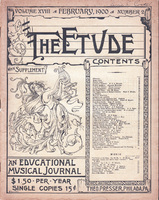Selected Content from the February 1900 Edition of The Etude
Mr. Ysaye is playing in London. Mark Hambourg has lately published two piano pieces: “Espièglerie” and “Minuet in F” Lillian Blauvelt and Frangcon Davies are singing in London. Rimsky-Korsakoff’s new opera “The Bride of the King” has been successfully produced… Read More
Listen to the voices of those who are tone-deaf, who are without a sense of tonality, and see if you do not miss something. The speaking voices of such remind me of nothing so much as of two boards being struck together, or the “clappers” in which boys delight. I remember, when at school, two boys being excused from singing because, on examination, they were found to be tone-deaf. This seemed to me most extraordinary at the time, but I have since met with many who are without any sense of pitch, tonality, or key-relationship. I want you to be sorry for these people, and to think of the pleasure they can never share with you. Read More
BY SEMBRICH. There are two big faults with the American girl who would sing. One fault is her temperament and the other fault is her hurry. She is a very proper girl and very nice girl, but she has not… Read More
W. R. B.—“Rag-time” originated in the South, where bands of colored musicians first played it. These bands are not usually organized, not uniformed, being volunteer affairs. The colored race is extremely imitative, and, all playing mostly “by ear,” any mistake or peculiarity made by one band, which happens to take their fancy, is readily taken up by all the others.
This music got its name from the rough appearance of the bands, which are called rag-bands, and the music rag-music, or “rag-time” music.
The popularity of “rag-time” music is certainly not diminishing, and it remains to be seen what effect it will have on the American music of the future. Read More
Notices for this column inserted at 3 cents a word for one insertion, payable in advance. Copy must be received by the 20th of the previous month to insure publication in the next number. “KINDERGARTEN MUSIC BUILDING,” BY NINA K…. Read More
Herr Schmoll’s works are mostly for the piano. Among the most used are his primary method; 80 etudes, op. 116-119, moderately difficult; 10 sonatas, op. 61-70; 50 “Grandes Etudes,” op. 121-123; and “Album de Lectures,” op. 96-99. A selection of his studies has been issued recently in this country. He has composed some two hundred drawing-room pieces, which are used extensively in France. The scene of his activity is Paris, where he publishes his work himself. His most popular composition in America is his “Spinnino,” which has been reprinted by most American publishers. Read More
BY FRANK B. MELVILLE. The melodeon which for so many years had rendered feeble, but faithful, service to the church at Kipley’s Corners was about worn out; and the church had voted to buy a large cabinet organ. The selection… Read More




